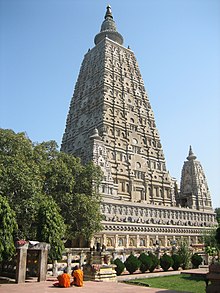
Back تاريخ البوذية في الهند Arabic ভারতে বৌদ্ধধর্মের ইতিহাস Bengali/Bangla Història del budisme a l'Índia Catalan تاریخ بودیسم در هند Persian भारत में बौद्ध धर्म का इतिहास Hindi A buddhizmus története Indiában Hungarian Sejarah Buddhisme di India ID Storia del buddismo in India Italian Историја на будизмот во Индија Macedonian ഇന്ത്യയിലെ ബുദ്ധമതത്തിന്റെ ചരിത്രം Malayalam
| Part of a series on |
| Buddhism |
|---|
 |





Buddhism is an ancient Indian religion, which arose in and around the ancient Kingdom of Magadha (now in Bihar, India). It is based on the teachings of Gautama Buddha[note 1], who lived in the 6th or 5th century BCE and was deemed a "Buddha" ("Awakened One"[3]). However, Buddhist doctrine holds that there were other Buddhas before him. Buddhism spread outside of Magadha starting in the Buddha's lifetime.
During the reign of the Mauryan Emperor Ashoka, the Buddhist community split into two branches: the Mahāsāṃghika and the Sthaviravāda, each of which spread throughout India and split into numerous sub-sects.[4] In modern times, two major branches of Buddhism exist: the Theravada in Sri Lanka and Southeast Asia, and the Mahayana throughout the Himalayas and East Asia. The Buddhist tradition of Vajrayana is sometimes classified as a part of Mahayana Buddhism, but some scholars consider it to be a different branch altogether.[5]
The practice of Buddhism lost influence in India around the 7th century CE, after the collapse of the Gupta Empire. The last large state to support Buddhism—the Pala Empire—fell in the 12th century. By the end of the 12th century, Buddhism had largely disappeared from India with the exception of the Himalayan region and isolated remnants in parts of south India. However, since the 19th century, modern revivals of Buddhism have included the Maha Bodhi Society, the Vipassana movement, and the Dalit Buddhist movement spearheaded by B. R. Ambedkar. There has also been a growth in Tibetan Buddhism with the arrival of Tibetan refugees and the Tibetan government in exile to India, following the Chinese occupation of Tibet in 1950.[6] According to the 2011 Census there are 8.4 million Buddhists in India (0.70% of the total population).
- ^ UNESCO World Heritage Centre. "Mahabodhi Temple Complex at Bodh Gaya". Archived from the original on 5 November 2020. Retrieved 27 February 2015.
- ^ Smith, Vincent A. (1914). The Early History of India from 600 B.C. to the Muhammadan Conquest Including the Invasion of Alexander the Great (3rd ed.). London: Oxford University Press. pp. 168–169. Archived from the original on 11 November 2021. Retrieved 11 November 2020.
- ^ Monier-Williams, Monier. Dictionary of Sanskrit. OUP. Archived from the original on 26 September 2013. Retrieved 30 September 2012.
- ^ Akira Hirakawa, Paul Groner, A history of Indian Buddhism: from Śākyamuni to early Mahāyāna. Reprint published by Motilal Banarsidass Publ., 1993, page 2.
- ^ "Buddhism: Description of the Vajrayāna tradition". Religious Tolerance. Ontario Consultants on Religious Tolerance. 25 April 2010. Archived from the original on 13 January 2017. Retrieved 26 November 2014.
- ^ "Tibet in India: A people's history of the Tibetan resistance". 22 July 2023.
Cite error: There are <ref group=note> tags on this page, but the references will not show without a {{reflist|group=note}} template (see the help page).